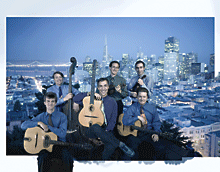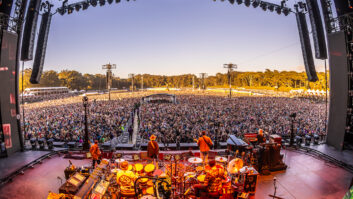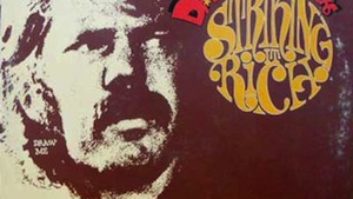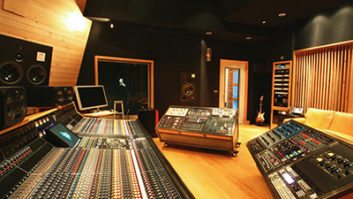

It’s been more than half-a-century since the great French gypsy jazz guitarist Django Reinhardt died of a cerebral hemorrhage at the age of 43. Yet his music — a wonderful fusion of swing cadences, jazz improvisations, waltzes, pop tunes and ageless gypsy melodies — has never been more popular than it is today. There are jazz festivals in America and Europe dedicated to his music, guitarists on nearly every continent devoted to learning and passing on his distinctive style, and acoustic ensembles attempting to capture some of the magic of Django’s legendary Quintet of the Hot Club of France and his other bands. In America, one of the most vital and creative groups that honors Django’s memory and has used his broad repertoire as a jumping-off point for its own original music is the Hot Club of San Francisco, led by the fine guitarist Paul Mehling, aka “Pazzo.” Now in their 13th year (though with many personnel changes along the way), the HCSF has just released their ninth album, Postcards From Gypsyland on the Lost Wax Records label, and has been playing more live dates than at any time in the group’s history. As this story was being written in early June, the CD’s opening track, “Not So Fast,” written by the disc’s producer, Adam Levy, was Number 12 on America’s Jazz Countdown chart of jazz radio airplay — quite a feat for this style of music.
The Hot Club of San Francisco: (L to R) Sam Miltich, Paul Mehling, Josh Workman; (rear) Ari Munkres, Evan Price and Oliver Manchon. photo: Terry Husbye
photo: Terry Husbye
“I never thought I’d see a Django revival or whatever you want to call all this interest in his music,” says an obviously pleased Mehling. “Part of me is a little concerned that it’s just a fad, but I don’t think the music is going to go away. The good news is that more people now know who Django is than in his lifetime. All of his records — even the outtakes that weren’t originally released — are in print right now, which is pretty crazy for a guy who’s been dead for more than 50 years.”
Why is it happening? “It’s hard to say,” Mehling answers. “Obviously, it’s great music. It has a lot of spirit. Beyond that, the world loves the guitar, and every couple of years, there’s a movement back toward acoustic music; also, every few years, it seems there’s a movement back toward jazz, so this plays into all that because it combines all those things.” Django’s music has been turning up on film soundtracks, in commercials and even on the hit videogame called Mafia (which is set in the ’30s). A popular biography of the guitarist — Michael Dregni’s Django: The Life and Music of a Gypsy Legend — came out last year to general acclaim.
“A lot of people are buying the guitars and learning the repertoire,” Mehling offers, “but it’s really hard to learn how to play this music unless you actually hang around gypsies — it’s really apples and oranges when Americans play this music and gypsies play this music. Even I have to keep humbling myself and go back to the gypsies to learn technical things.” In the years before he formed the HCSF, Mehling immersed himself in the style, playing with gypsies on the streets of Paris (this seems to be a rite of passage for serious students of the style) and playing for a spell with Dan Hicks, whose own twisted swing is clearly derived from Django’s.
From the HCSF’s beginning, Mehling has not been content to merely ape Django’s style and reproduce his tunes note for note. Rather, he has always played original songs that he and his band mates have written and used the acoustic ensemble as a forum to interpret songs in varying styles. On the group’s albums, the HCSF have covered songs by Fats Waller, The Beatles, Chick Corea, Benny Goodman, Rimsky-Korsakov and Thelonious Monk, among others — just as Django was an interpreter of popular songs (as well as a fine songwriter himself).
Postcards From Gypsyland contains a typically broad selection of tunes spanning many decades’ and countries’ styles, but always rooted in gypsy jazz — what the French called jazz manouche. The album amply showcases the current HCSF lineup’s expressiveness, grace and precision. In addition to Mehling, the band comprises violinists Evan “Zeppo” Price and Olivier Manchon (Django’s most famous musical foil was the great violinist Stephane Grappelli), rhythm guitarists Josh Workman and Sam “Sammo” Miltich (who is just 20 now and has been playing this music for many years already) and bassist Ari Munkres.

When the band performs live, “We try to give the audience a full meal,” Mehling says, “a little bit of this, a little bit of that; a little trio, a little quintet, a little septet, maybe even a solo or duo thing. We keep changing it up so the audience has to pay attention — ‘What’s happening now?’ We also try to have all of Django’s tunes in our book, so if someone comes up and asks us to play something really obscure, we can say, ‘Sure!’” he adds with a laugh.
Postcards From Gypsyland was recorded to Pro Tools last summer at Bay Records in Berkeley, Calif., then mixed on SSL G Series consoles at Different Fur in San Francisco and Dead Aunt Thelma’s studio in Portland, Ore., home base of the project’s engineer, Mark Orton, a fine musician and composer in his own right and leader of the Tin Hat Trio. Orton was the house engineer at New York’s famous Knitting Factory club for a couple of years and has toured extensively doing front of house for Bill Frisell, the Lounge Lizards, Mr. Bungle and John Zorn. Levy is also a guitarist of some note, having worked with Tracy Chapman, Norah Jones, Joey Baron, Sex Mob and others, and being a leader on a number of his own albums through the years. Levy and Orton have worked on several different projects together.
Orton describes Bay Records’ studio as “comfortable and a little funky.” Though he says the studio’s Otari console was occasionally problematic, “I made sure we had a lot of good equipment to work with. I come with several microphones and mic pre’s. I was using four modern Schoeps with MK4 capsules and the studio had two of the older 221s. There are several tracks where the instrumentation breaks down from the standard quintet. For the smaller ensemble tunes, I would try to mike the guitars in stereo — the standard six inches off the body [of the guitar] to the player’s left of the sound hole up on top — and as close as I could get without too much boom, although it’s a great-sounding room, so that definitely figured into the sound of the recording.
“Otherwise, I was going with single mics to play it a little safer phase-wise except on the bass, which I always mike with two microphones: a [Neumann] 87 and a KM84. I like to put a TLM 170 on top of the [violin] and then a Coles 4038 underneath behind the player, and I click it in out-of-phase and then I use that as my low midrange and midrange mic. It’s a warmth thing, so if I want to fill in the body of the instrument, I can, or I can leave it out if I want more shimmer. The great thing about the 4038 is that it’s a true ribbon mic with not much going on in the high end so it curbs the edginess of the violin. The violin and melodica were recorded in their own little room.
“I also had a [Neumann] SM69 FET up in the room, usually a little closer to the guitarists who were kind of bunched together; the bass was off in his own little gobo land to try to keep it clean. Finding the right balance and making sure everything stays in phase with that many live instruments individually miked in a big room like that is always a challenge, but this was all stuff I’m used to so it wasn’t too difficult. It helps that it’s a really well-tuned room and they’re all such good players. I’d say about 90 percent of it was cut live and there was very little in the way of fixes or edits; they changed a solo once or twice, but nothing major.” There was also some multiple tracking of the violinists to create a fuller sound on a couple of tunes.
“I was also using as many good preamps as I could come up with,” Orton adds. “They had a quad Millennia [at the studio] and then I have a pair of Tube-Techs. I have a quad Nightpro and a pair of Vintechs — they’re like 1073 knockoffs that are wonderful. They have a giant power supply, so they’re a little bulky to move around, but they sound great. I think I might have used the console preamps a little, too, but I mostly just used the console for monitoring.”
The album was cut over four days of 10- to 12-hour sessions; a fifth day was spent doing fixes. “It was pretty intense,” Orton says, “but Adam Levy had a laptop full of hysterical sound bites and if things ever got too heavy, he’d press the Talkback and play a recording of some weird soul singer who’d made this two-hour-long monologue of why Epic Records should sign him. He had all sorts of odd things and he always had them at just the right moment.”
For group leader Mehling, “Having a real producer and Mark Orton getting such gorgeous sounds really made this a great experience for us. In the past, we’ve never had enough money to make a great-sounding record, and this time, we just said, ‘Screw it. We’re going to really try to do it right.’ And it was definitely worth it — so far, the album’s doing great. The whole year has just been fantastic. We seemed to have turned a corner.”

Click below to hear samples from Hot Club of SF’s sizzling Postcards From Gypsyland

“Not So Fast,” written by producer Adam Levy, reached Number 12 on America’s Jazz Countdown chart of jazz radio airplay
“Theme From Gypsyland (Nuages)”
Hot Club in the Studio

Ari Munkres between takes

Engineer Mark Orton at the controls

Paul Mehling

From L to R: Paul Mehling, producer Adam Levy and Sam Miltich



